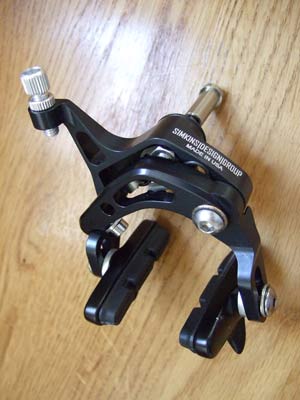 Looks good from 3/4… |
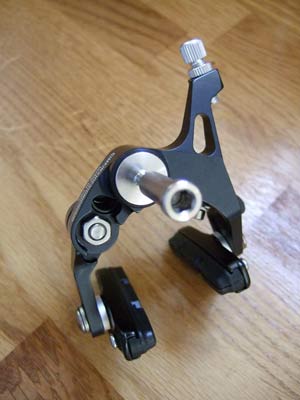 Simkins Skelters rear view… |
Simknins Designs Skelters Brake Calipers $274.99
First things first: Simkins Designs’ Skelters brake calipers do work. Once installed, they provide ample stopping power, good feel and a nice degree of modulation. Which you’d expect of brake calipers sold at £275 dollars per pair. The same could be said of the high standard of finish, the immaculate CNC machining and the choice of titanium for the centre bolt. Buy a pair and you’ll no doubt enjoy the ownership experience.
There is, however, more to Simkins’ Skelters calipers than their execution. They feature Coupled Dual Pivot actuation, use a novel means of clamping the inner wire and have an ingenious solution to the problem of holding the caliper for centring.
Why should this be a problem? Well, the way the caliper works has much in common with a conventional dual pivot design. However, since there is no stub arm to locate the C-arm and the latter is free to move relative to the Y-arm, it is not possible to hold the whole caliper steady by pinching either or both arms.
Instead, the centre bolt has to be held, which can’t be done with an open-ended spanner since the centre bolt does not have the space for flats. So, there’s a small plate sitting behind the C-arm attached directly to the centre bolt; a small 3mm hex hole accepts an Allen key to hold the caliper steady while the sleeve nut is tightened.
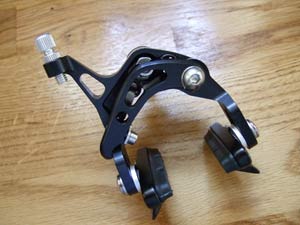 Simkins Skelters front view |
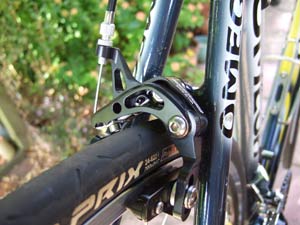 Neat fitment on cycle |
Time for installation. Specific instructions are supplied. I found it simplest to install the caliper with blocks roughly aligned with the rim, then squeeze them together to get the required gap. Then it is time to put a bend in the inner wire at just the right place. This takes the wire under the tip of the C-arm to the clamping screw and plate. Doing it this way allows Simkins to use a tiny clamp screw and lose some of the width of a conventional caliper.
With the bend in the desired place, the caliper can be removed from the machine, the left-hand block (looking at the caliper) and shoe removed for easier access and the inner wire clamped. Then the whole lot can be reassembled, the left-hand block aligned and the caliper centred using a 3mm Allen key while the nut is tightened.
Except that, as far as the front caliper was concerned, this was not possible. None of my 3mm keys would fit. Close inspection revealed that the 3mm hex in the plate described above appeared to have been filed by hand and was too small on at least two sides.
Better luck was had with the rear caliper, which I managed to get working nicely enough to be able to assess its performance. However, my initial suspicions concerning the geometry of the Coupled Dual Pivot concept were confirmed when I installed a pair of well-worn blocks to see what happened to adjustment.
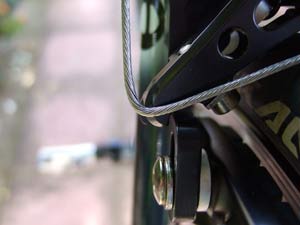 Bend inner wire… |
 … before clamping |
Bear with this; unlike a conventional dual pivot caliper, there is, as already stated, no separate stub arm for the C-arm (the one in front). Instead, the C-arm pivot is sited on the end of an extension to the Y-arm. Since the Y-arm pivots around the centre bolt to bring the left-hand block to the rim, the C-arm pivot also describes an arc around the Y-arm pivot. Now, when you first apply the brake, the C-arm block travels up to the rim first since it has a softer spring. As it reaches the rim and stops, the Y-arm begins to move to bring its block up to the rim but, as it does so, the pivot for the C-arm moves up and away from the rim.
With new blocks, this merely means that the right-hand block scrubs up the rim braking surface as it is squeezed tighter. As the blocks wear, however, and the left-hand block has to come further in to reach the rim, the C-arm pivot gets ever further from the rim. In turn, the C-arm block rides higher up the braking surface until, with the blocks about half-worn, it rides over the top of the rim and, were the worn blocks to be used past this point, would need to be adjusted to avoid cutting into the tyre sidewall.
All in all, the Simkins design does nothing that a conventional caliper doesn’t do and has significant drawbacks in comparison. Since it lacks a quick-release, the weight is not especially impressive at just 11g per caliper less than SRAM’s Rival. Add in the slightly awkward process of installing the cable inner wire and it is hard to see a good reason to fit Skelters calipers beyond their pose value and ‘trick’ appearance. Which itself is slightly spoilt by low-rent cable adjusters.
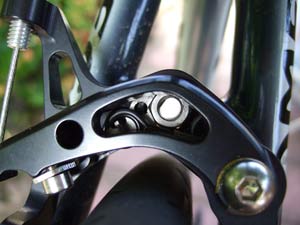 Centring hole just visible |
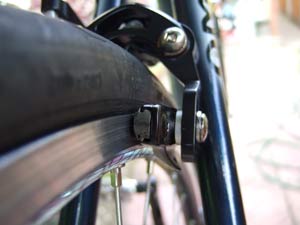 C-arm block rides up with wear |
Verdict
Trick looks can’t make up for flawed geometry
 Pose value, quality machining
Pose value, quality machining
 Inferior geometry to conventional dual pivot
Inferior geometry to conventional dual pivot



More at www.simkinsdesigns.com.





